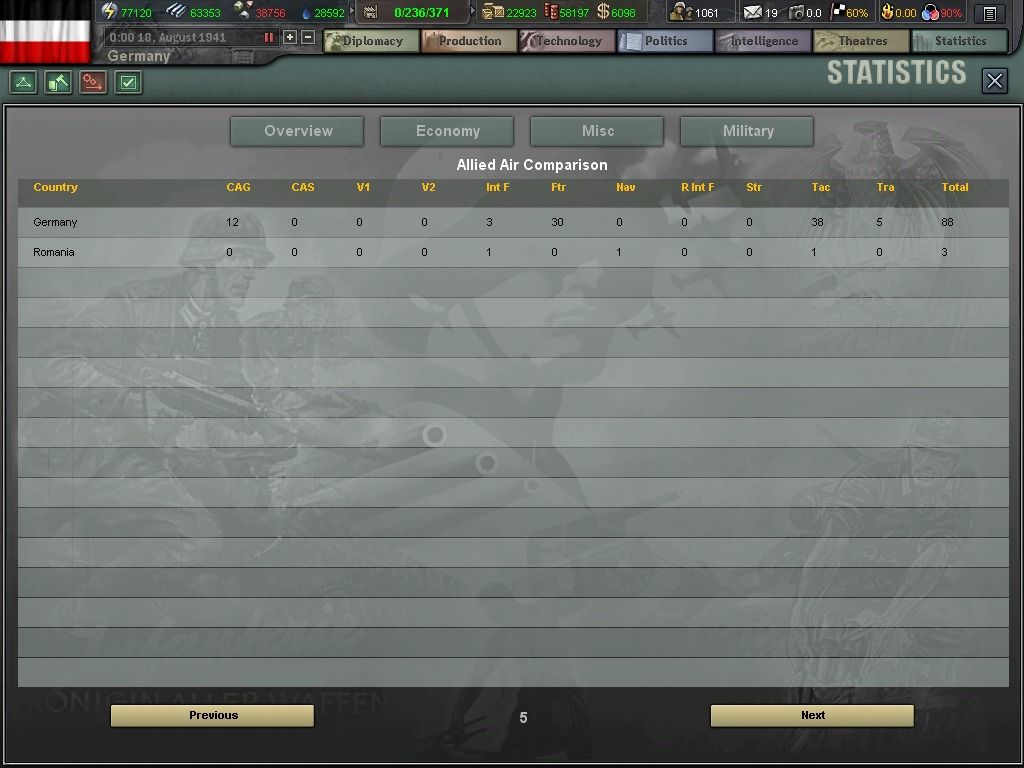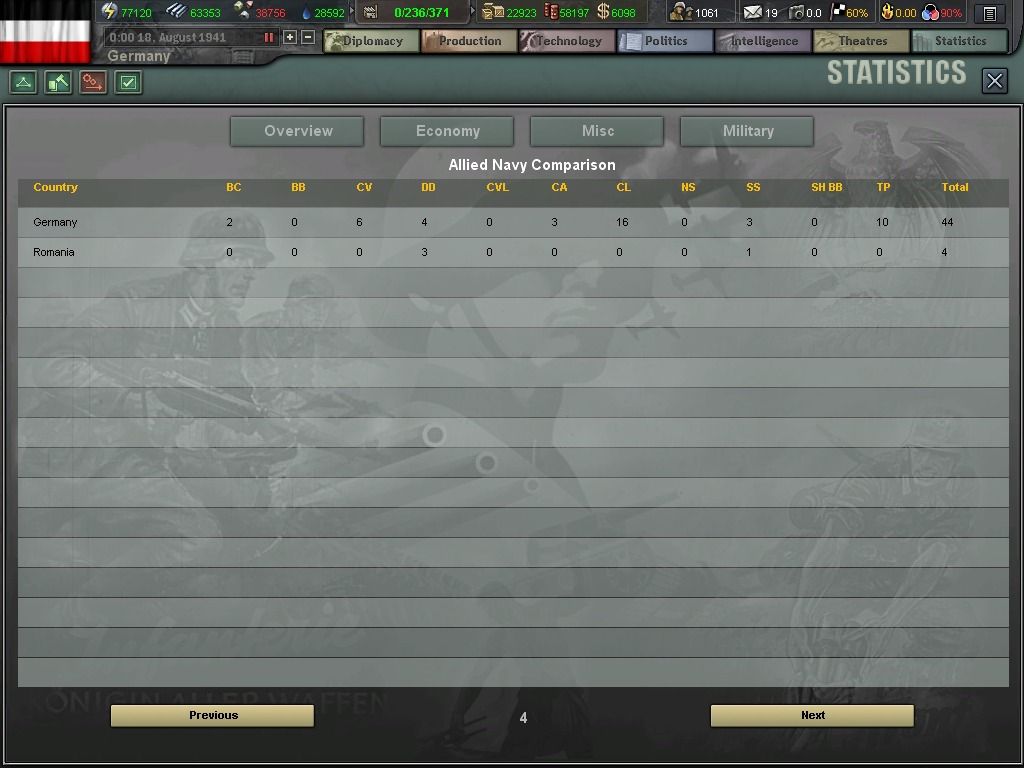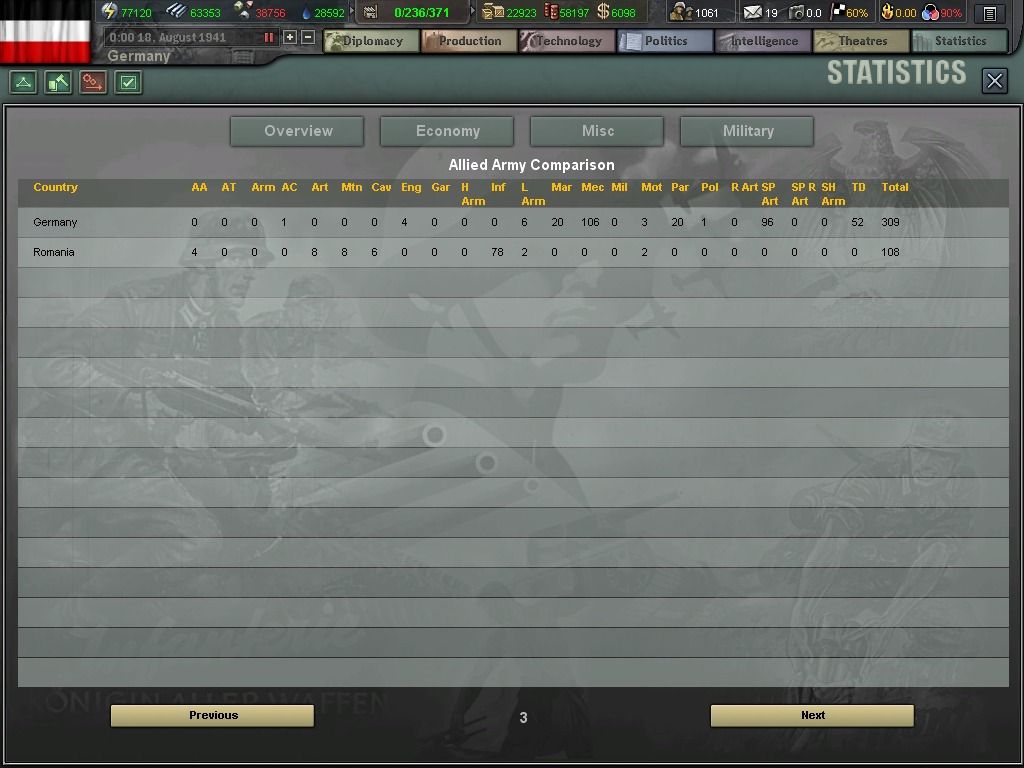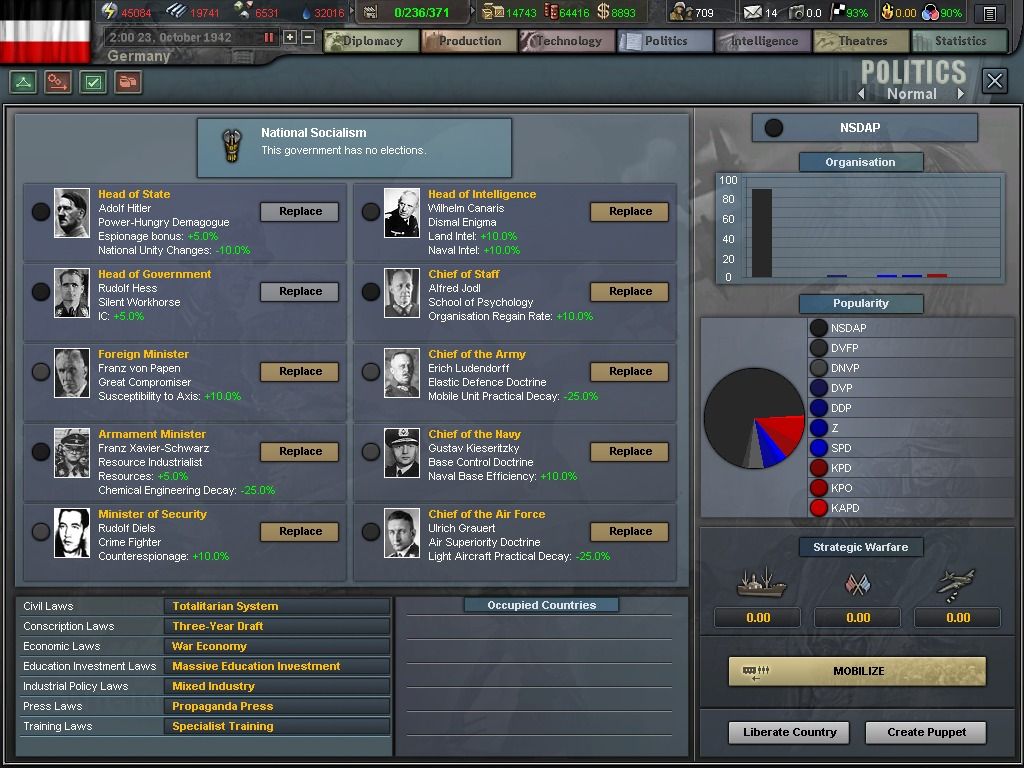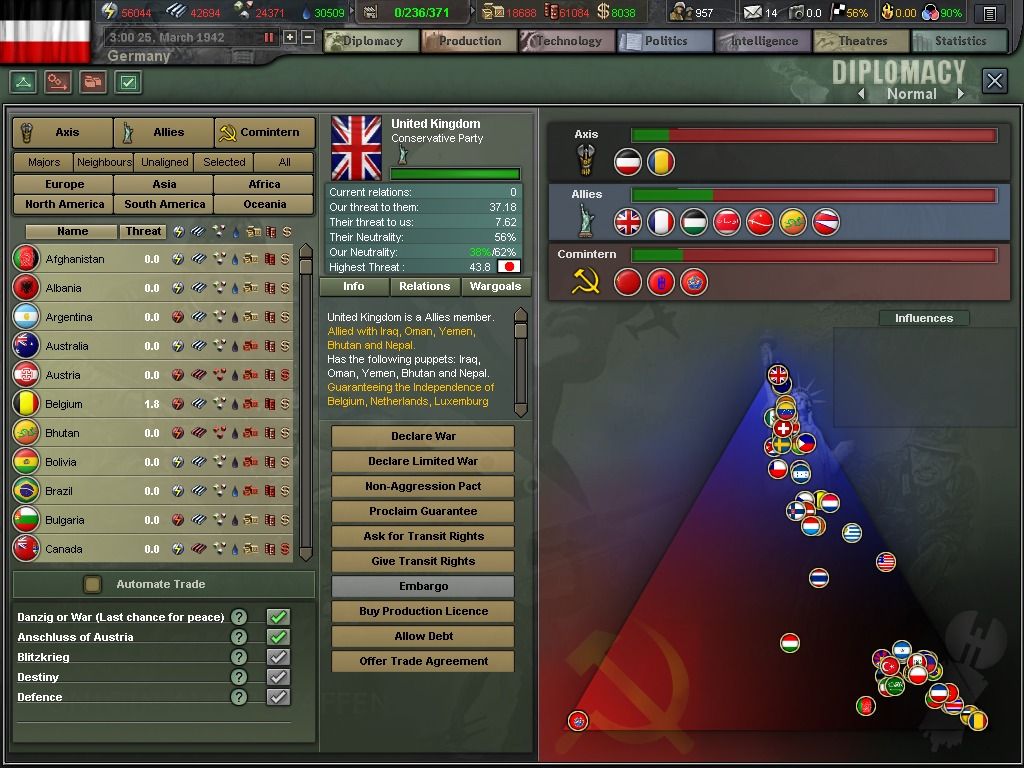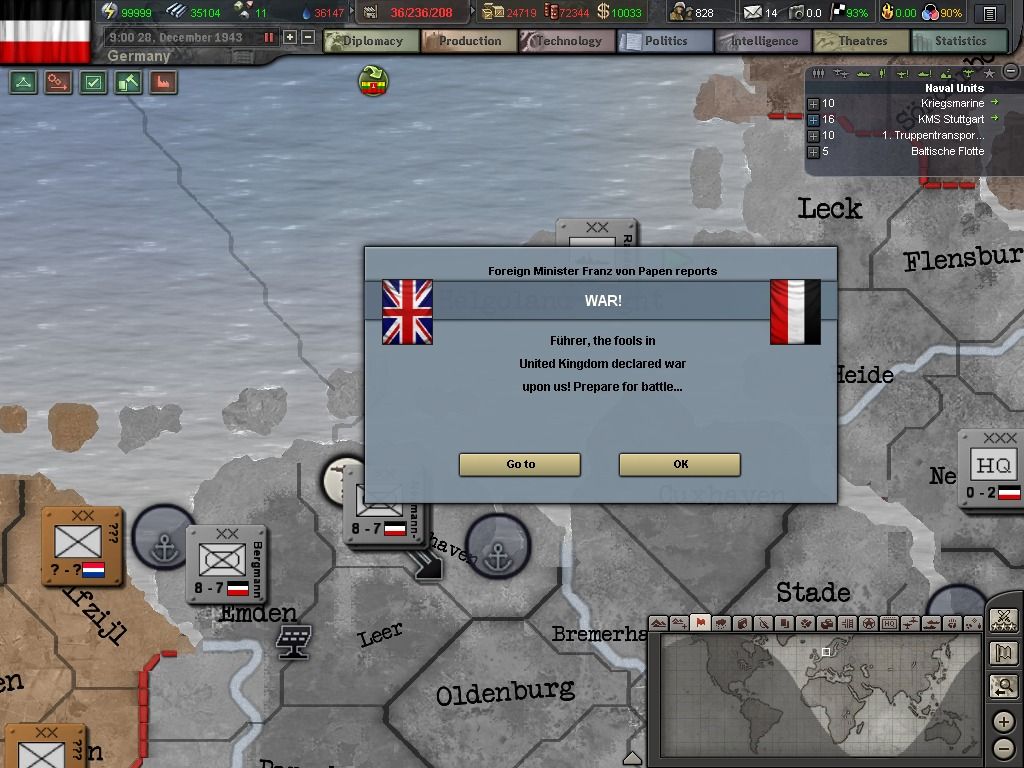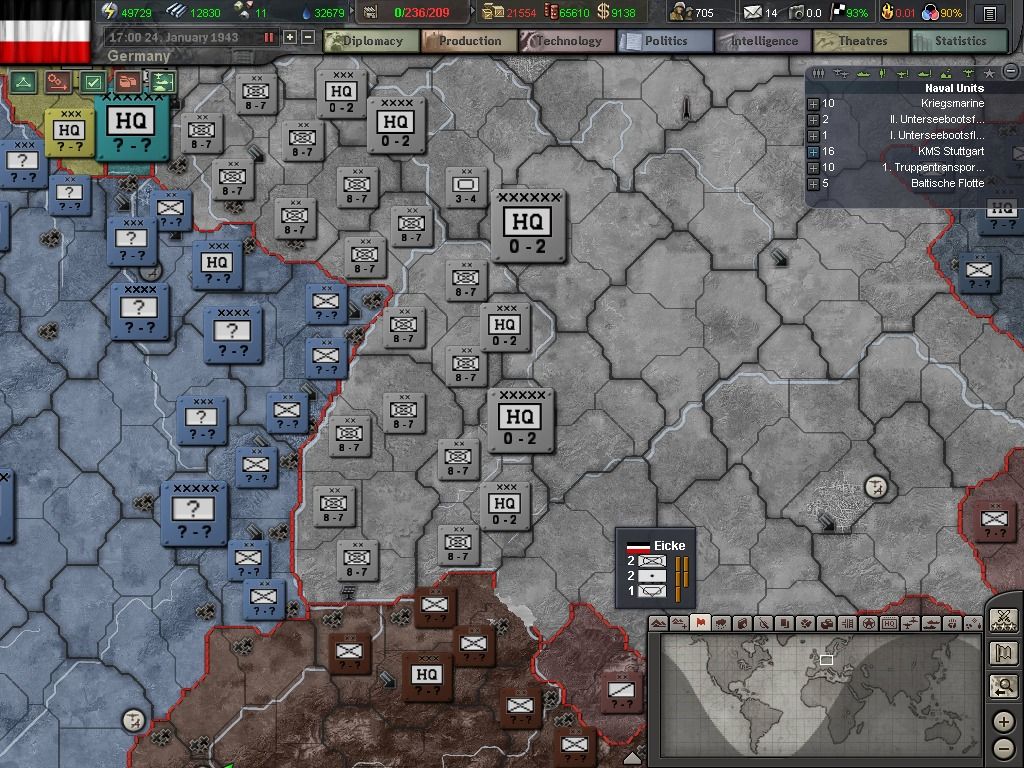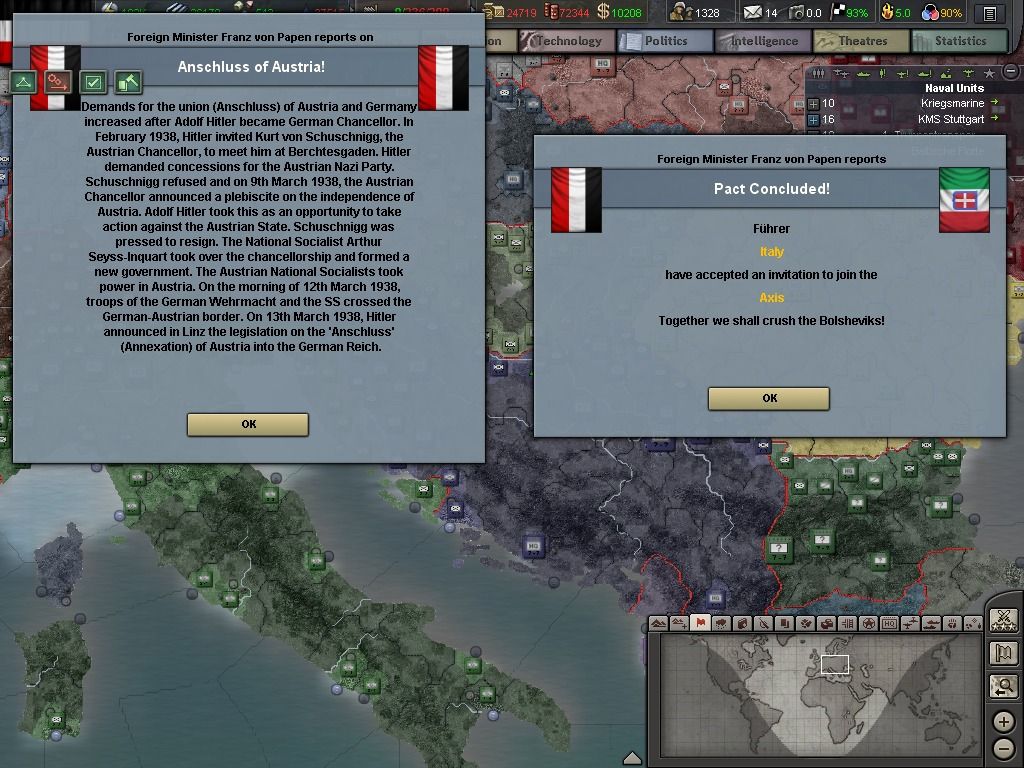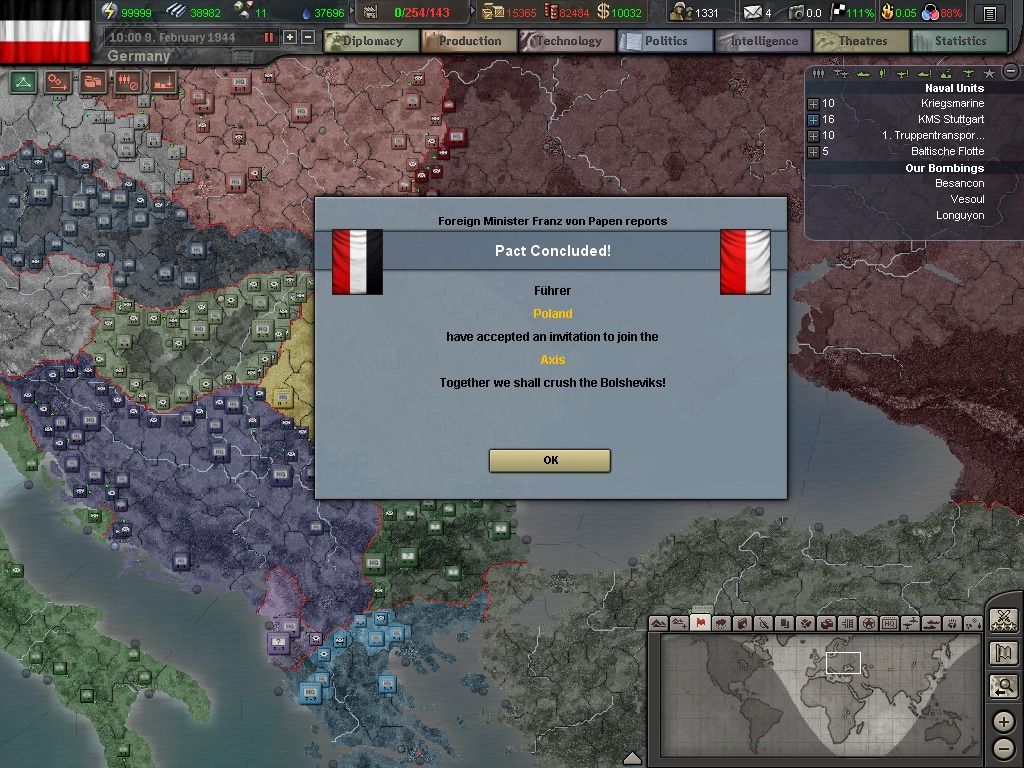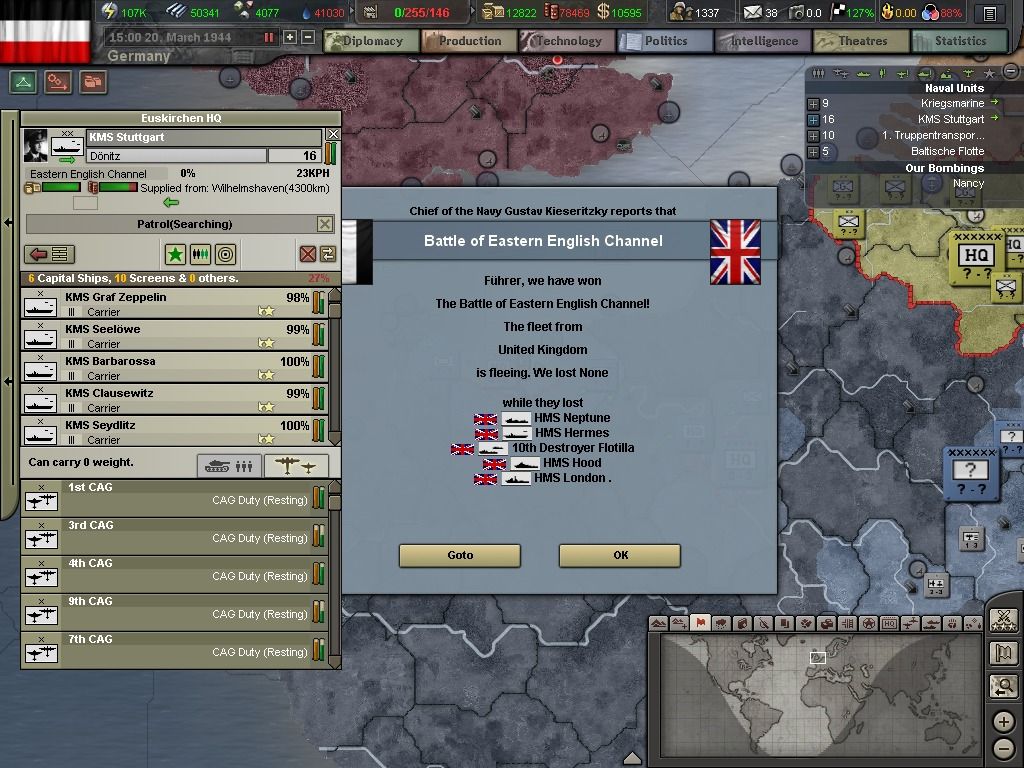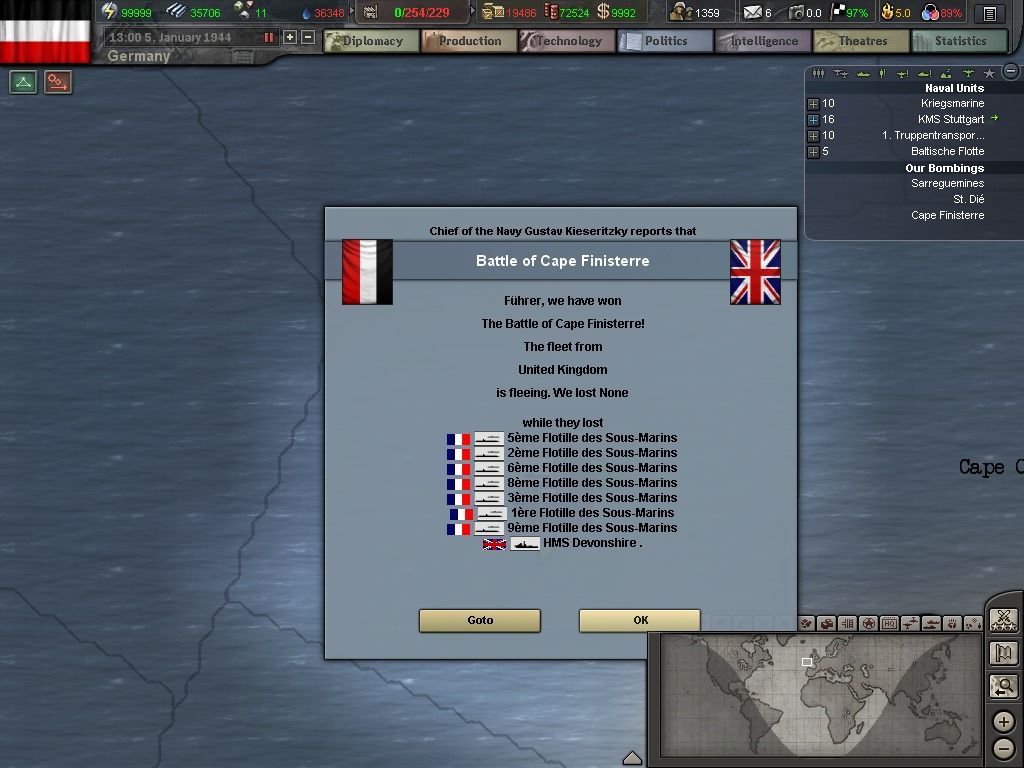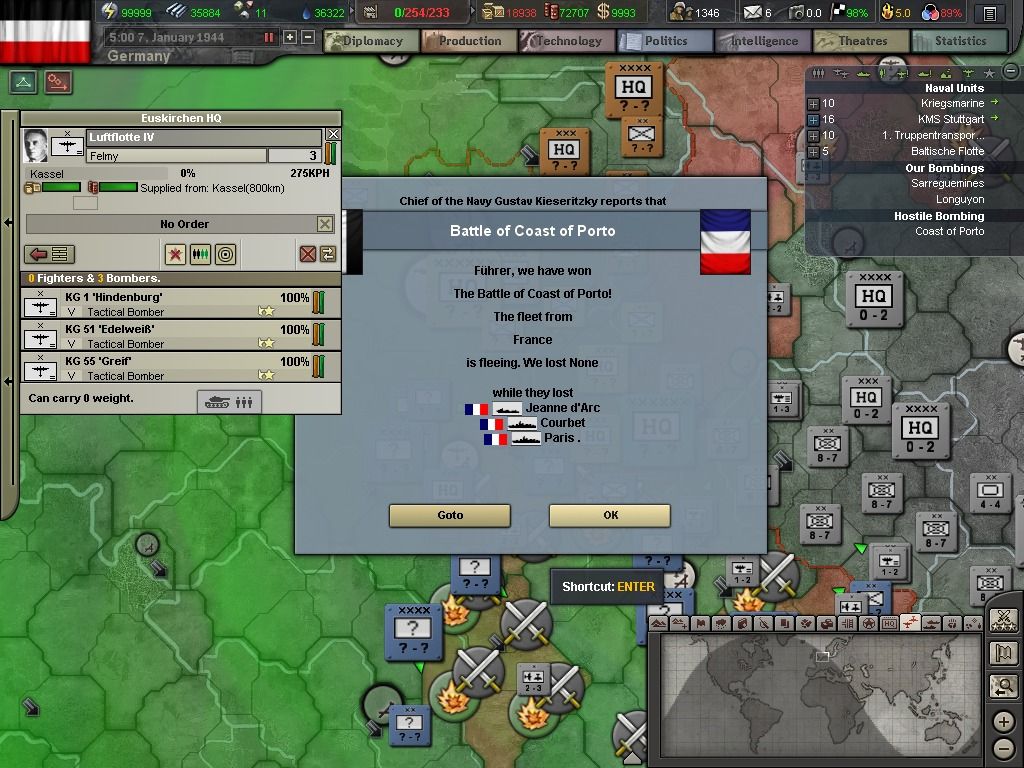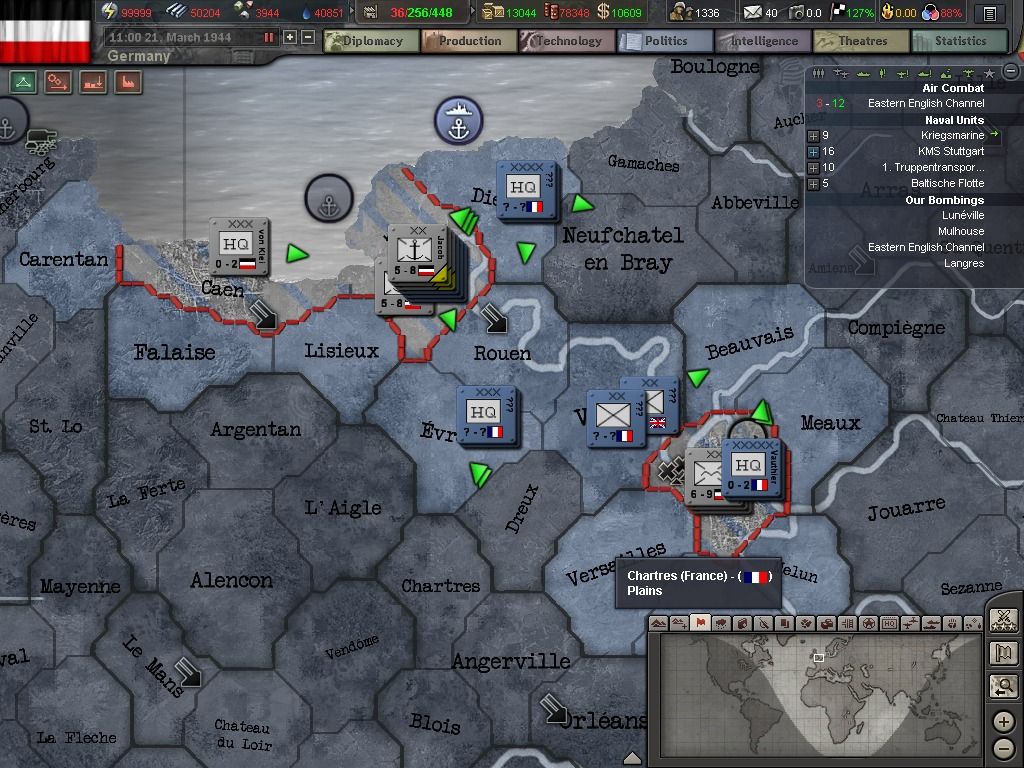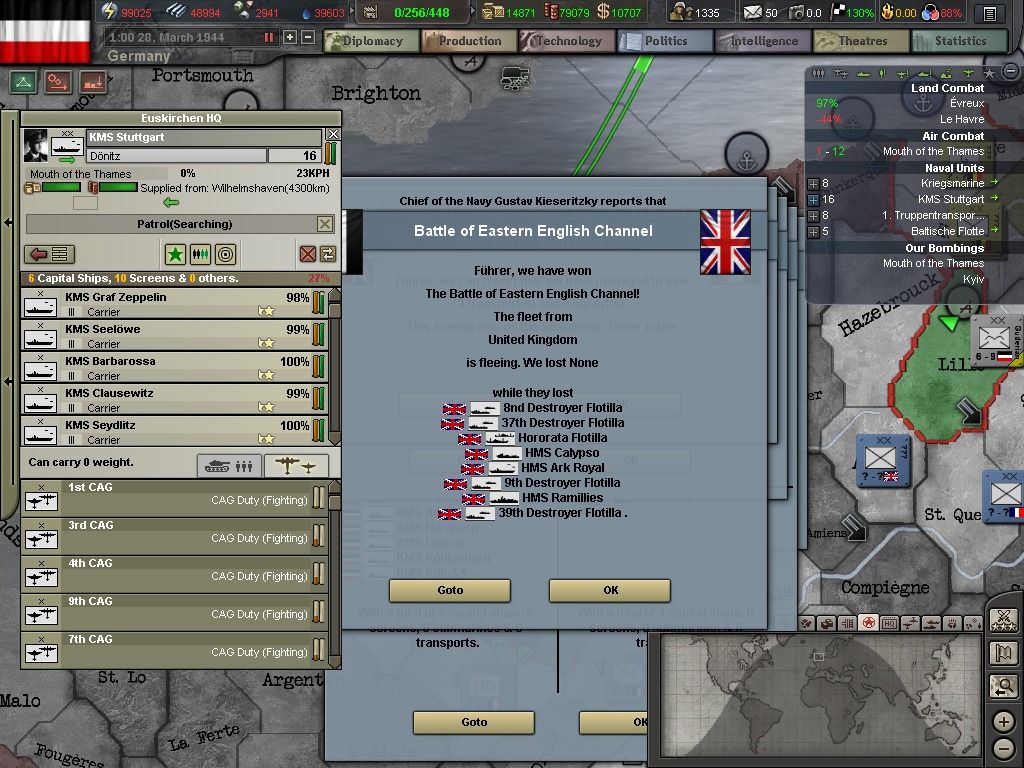Chapter 5: It’s a mad, mad, mad, mad, mad world.
So, the war has started. What now?
First, I tidy up some things.
Now that the war has begun, threat is largely irrelevant to my life. We annex Austria since our spies have been supporting our party for years on end. The manpower boost is nice, though I don’t really need it. The IC and resources are what I really want. Italy joins the Axis instantly. Surprisingly, Italy is a powerful ally. They performed amazingly well this game, but we’ll talk about that later.
But even as I start getting fleets and planes into action, this happens.
Germany is now in a two-front war. I anticipated this (and it took Stalin a few weeks longer to do it than I anticipated), but I have to live with the consequences of my choices. The Soviet threat, coupled with my generally congenial behavior, means that nations will start falling into the Axis without any real effort. However, I do not accept all of them immediately. Estonia, Latvia, Finland, Czechoslovakia, and Norway are all fairly eager to join during the first year of the war, but I want them to not die, so I refrain from inviting them until the Soviets are at a point where they cannot quickly annex any of them. Finland in particular is a sticky situation. I really need the Gulf of Finland effect because resources are being consumed quickly, but I can’t fire it until I own Leningrad anyway. So, the Finns are sidelined until the situation warrants their entry into the war.
It is awesome to see Poland willingly join the Axis, though. That’s worth the price of admission right there.
But what strategy should Germany pursue? I could, hypothetically, try to fight tooth and nail on both fronts, but I’ll be honest. I’ve tried it, and it lead to the game where I defeated the Allies but the war with the Soviets became a WWI slugfest 50 kilometers from Moscow, with Germany at a deficit of 500 manpower and the Soviets at a deficit of 800 manpower. Not a real win for anyone.
Instead, I toggle AI control in Berlin Theater, attach about half the Luftwaffe, and tell Berlin to defend a line of provinces through the middle of Poland that roughly corresponds to the demarcation line of the historical M-R Pact. This is just a coincidence; I really want the defense line to be well within range of that level 10 RADAR in Lotzen (remember that?) and the huge airfield I built there. I want Rommel and Gunderian, as Army commanders, to dig in and defend there while the Luftwaffe can cover them using RADAR and base proximity bonuses in combat. Combined with the technological and doctrine advantage I have over the Soviets, the outnumbered air wings attached to Berlin Theater will have the overall advantage. The only downside to this plan is that the Polish army doesn’t seem to grasp the situation and fights pointlessly hard in provinces I have no intention of covering. But that’s the AI for you.
What about France?
Shall I run a standard invasion of France? I can’t. Invading the Netherlands and Belgium is a no-no with my house rules. Besides, they willingly join the Axis later. I’m the nice guy, so no invasion through the Low Countries (not even tiny little Luxembourg). And they won’t join the Axis until Europe is more or less secured from the Allies anyway, so I can’t have them join the Axis and invade via my allies in the Low Countries either. (There may be a way to convince them, but it was faster to just do my own thing.)
How about just storming the damn Maginot Line? How about no. Yeah, I know, I have uber-combined arms bonuses. And yes, I can bomb the French army into dust. And I can even drop PARA into Metz or on the line itself to open up additional axes of attack, but all of that is a waste. Germany would rather spend its hard earned industrial advantage in other ways. Upgrades aren’t cheap, and even with practicals, new divisions are pricey. MECH and TDs are just not cheap to fix when they get shot to Hell. Besides, guess who didn’t build engineers?
Okay, how about just taking Paris with PARA? Yeah, that would fire the Fall of Paris event, but I won’t just ninja Paris and then pretend that is a real strategy that somehow showcases the kinds of options available in a late-war scenario.
Instead, I create Fall Rot. The plan involves a number of distinct phases for all three major arms.
Phase I:
Defend Germany.
The army deploys 1 division to each province opposing the Maginot Line. This might seem like a miniscule drain of resources, but bear in mind that I don’t have 50 billion divisions. All those divisions represent a significant portion of Germany’s land forces. However, given terrain and combined arms bonuses, we don’t need more than 1 in each province, even after the BEF shows up, stacking 5-7 divisions per province.
All MR fighters not fighting the Soviets run air superiority over French airfields. My starting INTs cover areas from strategic bombing. TACs not fighting the Soviets get tasked to ground attack French units near the Maginot Line, but not on it. Those STRs I build begin logistic bombing three provinces behind the Maginot Line.
The goal of the initial portion of the air campaign is to establish air superiority, damage the French strategic reserve while avoiding bomber losses against the provincial AA of the Maginot Line, and to bomb the BEF as it comes into that part of the front. The logistic bombing is there to kill the ability of all units near the Maginot Line to fight or move effectively, especially the mobile units. It takes weeks, but I am able to cut both fuel and supplies going to the Maginot Line to practically nothing. Three hour probing attacks on the Maginot Line reveal that all units are at least at the -39.9% penalty for lack of supplies, and some are completely out of supply. Mobile units are moving slow due to lack of fuel, and foot units have to run the gauntlet of TACs at their default speed if they want to leave the front.
In other words, the majority of the French Army and the BEF are locked in place; the place where I have no intention of attacking.
Donnitz is placed in command of the CTF and he goes into the North Atlantic outside British land based air cover. He positions the German fleet over our own overseas trade routes, which also overlap with some British convoy routes. The CTF runs patrol missions, killing convoys and protecting German convoys (not many left since the USA isn’t trading with anyone anymore, but still they could use some coverage), forcing both the French and British navies into fighting in on equal terms. The goal is for Donnitz to maim both navies while Italy runs amok in the Med, killing as many ships as possible and keeping the others in port with damage and low ORG.
During this period, remaining upgrades go to the army (the planes and ships had priority before the war started) and I get the officer ratio up. By the time the Luftwaffe and Donnitz have softened the enemy, the officer ratio will be at 140% and phase 2 can commence.
The German navy performs phase 1 admirably.
Phase 2:
Everyone gets a break, except the STR.
The navy takes a short break to repair damage. This is important because the navy needs to be at full strength for Phase 3.
The Luftwaffe starts giving TACs more holidays to regain ORG and repair. The air superiority campaign get some micromanagement attention with the fleet in port. Air superiority missions start being flown further into France, leaving airfields near the Maginot Line somewhat free to operate.
Special forces embark on planes and transport ships. Additionally, MECH forces are also loaded on transports. The pre-1936 German navy is assigned escort and sails into the Channel once Donnitz and the CTF are ready. The CTF goes ahead of them.
Phase 3:
The officer ratio takes a hit as a number of new divisions finish building simultaneously. (Heavy Industry emphasis). Had I planned better, I might have delayed Fall Rot. But, the results are still spectacular.
PARA take Paris, MAR secure a beachhead, but the follow on mechanized forces are already in the Channel. The moment the MAR take the ports, MECH can go ashore and start running around. You can’t see it, but within two days, MECH are already close to linking up with the PARA in Paris. The majority of France’s army and the BEF are stuck on or near the Maginot Line. They are kind of bombed out, out of supply, and unable to move quickly to respond to the threat.
Note that the logistical bombing in 3.06 does not hurt infrastructure too much; but the lack of fuel really prevents those mobile units from reacting to the invasion quickly. And since they’ve been hurting for supplies while being bombed badly, the strategic reserve is also kind of shot up. The units that might help the most are least able to do so.
The Fall of Paris fires slowly this time, so I’ve actually linked up with the PARA and have MECH running all the way to the end of Brittany before the French surrender. Germany has added the puppet wargoal to all members of the Allies, so France remains completely intact, but they are now at war with the Soviets. The BEF is kind of in limbo, unable to do much of anything.
The CTF has to retire to port for a few months to repair those CAGs, but the damage sustained by the RN is severe. The loss of the Ark Royal is particularly painful. But the RAF is still in the fight and it will be some time until an invasion of the UK can be launched.
With France now in the Axis, most of the Germany army can now be posted in Poland. However, before any significant offensive can be undertaken against the Soviets, we have to do something kind of counterintuitive.
That will be in the next installment.


